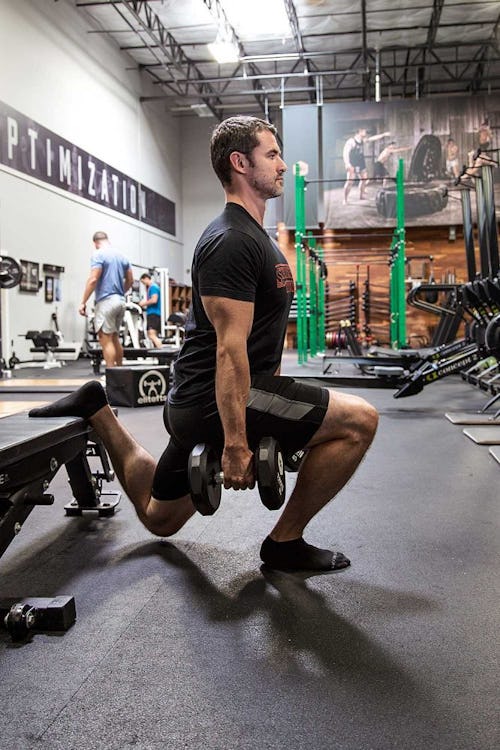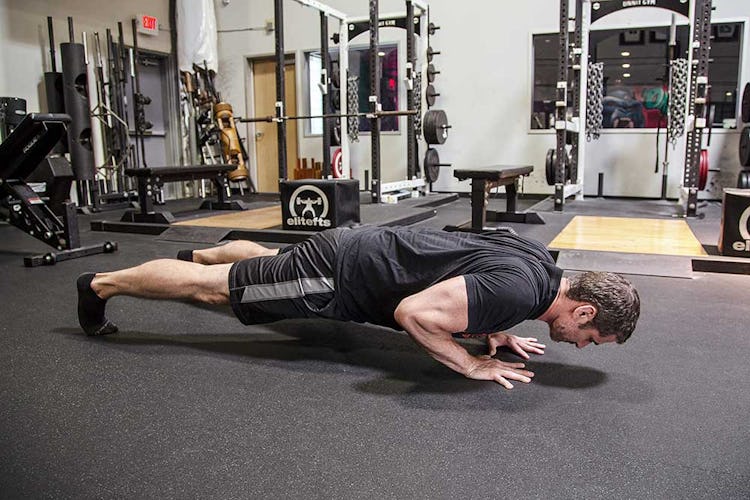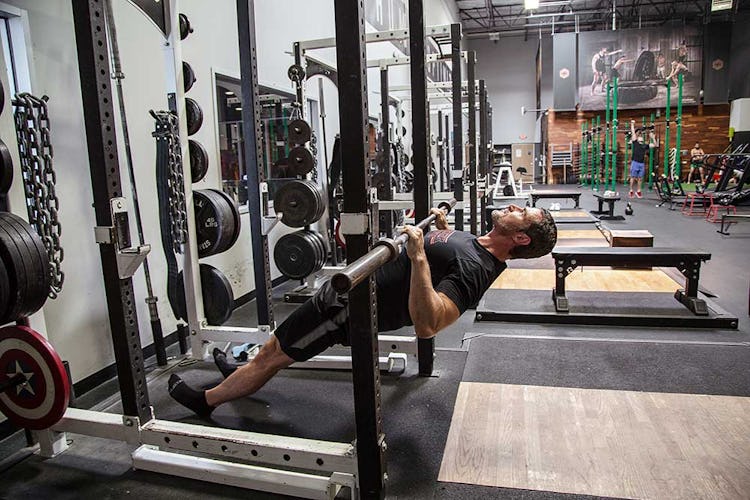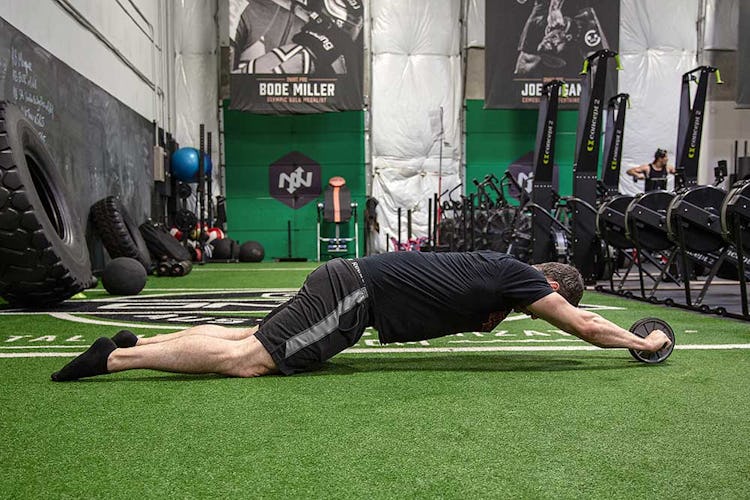Oh, life. It’s tough. And living it in shape is even tougher. You have to lift weights. You have to do cardio. You have to eat healthy… You can’t just take a magic pill that makes you strong and lean (well, maybe you can, but it’s illegal without a prescription). Wouldn’t it be great if you could just do one workout that covers everything, and then get back to the rest of your life?
Actually, you can. Sorta. You still have to eat healthy (and avoid magic pills), but you can save a lot of time and worry by combining lifting and cardio into one routine. That’s the premise behind circuit training.
The following is an excerpt adapted from the Men’s Health Encyclopedia of Muscle, written by Onnit’s own Editor-In-Chief, Sean Hyson, C.S.C.S. For more ideas on how to design your own workouts, pick up the book HERE.

How To Do Circuit Training
A circuit is a bunch of exercises done in a row that train the whole body. Going through the circuit raises your heart rate, so it counts as a cardio workout too. When a 2013 study pitted circuit training against endurance training, researchers found that subjects who did circuits lost more fat and saw greater improvements in blood pressure as well as other blood markers. Because circuits combine strength work and cardio, they burn lots of calories and keep the metabolism boosted for hours.
Here’s the basic formula for setting up a circuit, courtesy of Don Saladino, a trainer to celebrities and pro athletes in New York City (follow him at @donsaladino on Instagram): “I have people do a lower-body exercise, then an upper-body push, an upper-body pull, and a core exercise.” If you have the time and the space, Saladino recommends repeating the order with different exercises that satisfy the same categories, in order to work the muscles a bit more thoroughly. For example, if you did a goblet squat, incline dumbbell bench press, lat pulldown, and plank in the first round, you could perform another circuit with a Romanian deadlift, overhead press, dumbbell row, and Pallof press to finish the workout. If you like, you can also tack on what Saladino calls a metabolic finisher, which is anything that gets you breathing hard—jumping rope, a treadmill or bike sprint, or mountain climbers. Don’t do more than 10 total exercises. The longer your circuit goes, the more you’ll fatigue, and the greater the risk that your form will get sloppy.
The goal is to train the whole body, so make sure that whatever muscles you work in your next exercise are different from the ones in your previous lift. Multiple exercises done in succession for the same area are more commonly called a giant set (also explained in The Encyclopedia of Muscle.) Another tip: choose exercises that will allow you to keep a steady pace. If you follow a hard, highly fatiguing exercise such as a back squat with another demanding lift like a barbell overhead press, you may exhaust yourself before you finish the circuit. By the same token, if you make up a circuit of relatively easy isolation exercises—say, curls, triceps pushdowns, and calf raises—you won’t get much of a cardiovascular challenge. Aim to alternate harder lifts with easier ones.
Saladino recommends keeping the reps for each exercise to around 10, and performing two to four total rounds. Rest for 15 seconds between exercises, or about as long as it takes to get into position for the next one, and 60 seconds at the end of each circuit. If that’s not enough rest, note how long it takes you to feel ready to go again, and, when you’re up for it, do just one more round, and call it a day. Over time, aim to reduce your rest period. The entire workout should take 20 to 30 minutes.

The Problem With Circuit Training
As simple as circuit training is, many people manage to make it less effective and more dangerous by going overboard. “If there’s one thing that makes me want to leave the fitness industry,” says Saladino, “it’s how clients equate success. They often think that they have to be pushed to the brink to see results, and that’s not true.”
Your circuit should never make you throw up or collapse on the floor from exhaustion. That won’t help you see results faster, but it can easily lead to sickness and injury. “I want clients to get through every exercise feeling successful,” says Saladino. “I’m not going to beat the living crap out of you with a workout.” So if it’s punishment you want, hire a dominatrix.
How Many Calories Does Circuit Training Burn?
According to research from Harvard, men and women who range in weight from 125 to 185 pounds can burn between 240 and 355 calories in 30 minutes of circuit training, which is approximately 150–220 calories more than you could burn with the same amount of conventional strength training. The exact number of calories you’ll burn, however, is very hard to estimate, and depends on many factors, such as your age, the intensity of your circuit, and the amount of muscle mass you already carry.
Is Circuit Training The Same As CrossFit?
While many of CrossFit’s WODs include some types of circuits (such as Cindy and Murph, for example), the two terms are not synonymous. Some CrossFit workouts emphasize strength and power, whereas true circuit training typically focuses on conditioning and fat loss.
Sample Bodyweight Circuit Workout
This circuit can be done using bodyweight alone, if you choose, and the workout takes only 15 to 20 minutes to complete. Perform the exercises in sequence, completing one set for each and resting 15 seconds between moves. Rest 60 seconds after the last exercise, and then repeat the circuit for two to four total rounds.
1. Bulgarian Split Squat
Reps: 10 (each leg)

Stand lunge-length in front of a bench or other elevated surface. Bend one knee and rest the top of that leg’s foot behind you on the bench. Keeping your torso upright, lower your body until your rear knee nearly touches the floor, or you feel a good stretch in your hip. Complete all your reps on one side, and then repeat on the other leg. Hold dumbbells as shown to make it more challenging.
2. Close-Grip Pushup
Reps: 10

Place your hands on the floor, inside shoulder width, and extend your legs behind you. Tuck your pelvis under, draw your ribs down, and brace your core so your body forms a straight line. Pull your shoulder blades together as you lower your body toward the floor, tucking your elbows 45 degrees to your sides. When your chest is just above the floor, press back up, spreading your shoulder blades apart at the top.
3. Inverted Row
Reps: 10

Grasp onto a bar, rings, or other sturdy object that’s set to about hip level. Your hands should be shoulder-width apart. Walk your legs forward and hang from the bar so your body forms a straight line. Draw your ribs down and brace your core. Pull your body up to the bar until your back is fully contracted.
4. Ab Wheel Rollout
Reps: As many as possible

Kneel on the floor and hold an ab wheel beneath your shoulders. Draw your ribs down, tuck your tailbone, and brace your core, so that your head, spine, and pelvis form a straight line. Roll the wheel forward until you feel you’re about to lose tension in your core and your hips might sag. Roll yourself back to the starting position.


)






